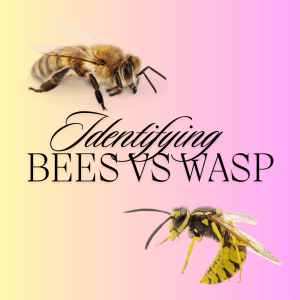
When you encounter flying insects around your home or garden, it’s important to know whether you’re dealing with bees or wasps. While both are essential to our ecosystem, their behaviors, physical characteristics, and interactions with humans can be quite different. At Bee Removal Logics, we specialize in humane bee removal and want to help you understand the key differences between these two insects. This knowledge can help you respond appropriately and maintain safety around your property.
Physical Differences
- Body Shape and Texture
- Bees: Bees generally have a robust, hairy body which helps them collect pollen. Their hairs are often branched, aiding in pollen collection.
- Wasps: Wasps have a slender, smooth body with a narrow waist. They lack the dense hair found on bees.
- Coloration
- Bees: Typically, bees have a more muted coloration with shades of yellow, brown, and black.
- Wasps: Wasps often have bright, contrasting colors like yellow and black, making them appear more aggressive.
- Wings
- Bees: Bees have two pairs of wings, with the hind wings smaller than the front wings.
- Wasps: Wasps also have two pairs of wings, but they tend to be longer and more slender in proportion to their bodies.
Behavioral Differences
- Aggressiveness
- Bees: Generally non-aggressive and will only sting when threatened. Honeybees can only sting once, while bumblebees can sting multiple times.
- Wasps: More aggressive and can sting multiple times. They are more likely to defend their nests aggressively.
- Nesting Habits
- Bees: Bees prefer to nest in hives, which can be found in hollow trees, beekeeping boxes, or inside structures like walls or attics.
- Wasps: Wasps build paper-like nests often found hanging from eaves, tree branches, or in the ground.
- Diet
- Bees: Primarily feed on nectar and pollen, which they collect from flowers.
- Wasps: Predatory and scavengers. They feed on a variety of insects, meat, and sugary substances.
Importance in the Ecosystem
- Bees: Vital pollinators for many plants and crops. Their role in pollination is crucial for the production of fruits, vegetables, and nuts.
- Wasps: Act as natural pest controllers by feeding on other insects. They help maintain the balance in the ecosystem by controlling pest populations.
What to Do If You Encounter Bees or Wasps
- Stay Calm: Sudden movements can provoke both bees and wasps. Move slowly and calmly away from the area.
- Avoid Swatting: Swatting can make the insects feel threatened, increasing the likelihood of being stung.
- Protective Measures: Keep food and sugary drinks covered when outdoors. Avoid wearing bright colors and strong perfumes that can attract bees and wasps.
- Identify the Nest: If you spot a nest, observe from a safe distance to determine if it belongs to bees or wasps. This can help in deciding the appropriate action.
When to Call a Professional
If you have a nest on your property or are experiencing frequent encounters with bees or wasps, it’s best to call a professional. Our team at Bee Removal Logics we specializes in humane bee removal and can safely relocate bee hives. For wasp nests, we work with pest control partners to ensure the safe and effective removal of these pests.
Contact Us
For expert assistance in identifying and removing bees or wasps, contact us at 619.654.6461. We are committed to providing humane and chemical-free solutions to keep your home and garden safe.
By understanding the differences between bees and wasps, you can take the appropriate steps to manage their presence around your home. Remember, both play significant roles in our ecosystem, and with the right approach, we can coexist peacefully with these fascinating insects.
